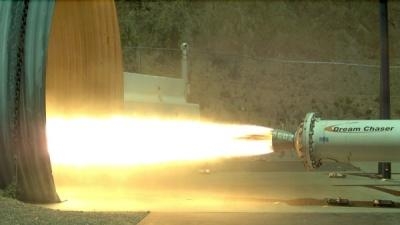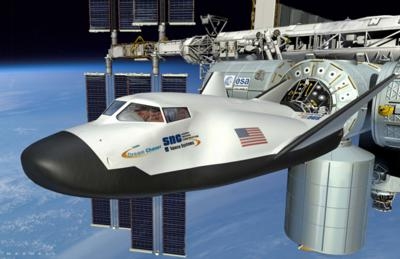Sat, Jun 08, 2013
Two Tests Completed This Week In San Diego, CA
Sierra Nevada Corporation (SNC) has begun the latest phase of hybrid rocket motor qualification testing for the Dream Chaser flight vehicle. SNC completed two tests this week at its rocket test facility in San Diego, CA. A motor firing and ignition test was completed in preparation for upcoming motor tests under the current Commercial Crew Integrated Capability (CCiCap) award. SNC will conduct another series of hybrid motor firings to meet the next CCiCap contracted milestone beginning this summer.

After required modifications were completed, the test firing was conducted in order to validate Dream Chaser’s motor test stand. This was after required modifications were completed and to ensure that SNC can move forward with the future heavy weight motor test series with minimal test stand risk. The Dream Chaser version of the hybrid rocket motor was last tested in 2010 under the Commercial Crew Development Program (CCDev1) Space Act Agreement during which SNC completed three successful test firings of a single hybrid motor in one day.
In addition to manufacturing these motors for Dream Chaser, SNC also manufactures the hybrid motors for Virgin Galactic’s SpaceShipTwo vehicle which has undergone test firings on dozens of hybrid motors over the last two years. As announced in the SNC news release (April 29, 2013), SpaceShipTwo successfully completed its first powered flight test using SNC’s hybrid motor to power the vehicle to an altitude of 55,000 feet and reaching Mach 1.2.

“We are eager to begin the next series of motor testing for Dream Chaser,” said Mark Sirangelo corporate vice president and head of SNC’s Space Systems. “With the successful qualification this week in San Diego and the success of the powered flight of SpaceShipTwo, we are even more confident that our hybrid motor technology is the safest and most reliable system for human transportation.”
SNC’s hybrid rocket systems offer a safe, high performing, and non-toxic alternative to solid and hydrazine liquid propulsion systems. As the rocket motor fuel is industrial rubber, there are no special handling or transportation requirements, which greatly reduces the lifecycle cost to customers.
(Images provided by Sierra Nevada Corp.)
More News
From 2023 (YouTube Edition): "Ain’t Your Daddy’s Super Cub”—Don Wade Co-owned by Don and Ron Wade—the former of Don’s Dream Machines, a storied >[...]
Pilot-Rated Passenger Reported That The Pilot Did Not Adequately “Round Out” The Landing Flare And The Airplane Bounced And Yawed To The Right Analysis: The pilot state>[...]
Dead Reckoning Dead reckoning, as applied to flying, is the navigation of an airplane solely by means of computations based on airspeed, course, heading, wind direction, and speed,>[...]
Aero Linx: Lake Amphibian Club This website is created and sponsored by the Lake Amphibian Club, to help spread the word about these wonderful, versatile amphibians that can land j>[...]
“I am deeply honored to be sworn in as NASA administrator. NASA’s mission is as imperative and urgent as ever — to push the boundaries of human exploration, ignit>[...]
 Classic Aero-TV: In Praise of Alabamas Patriot Aircraft USA
Classic Aero-TV: In Praise of Alabamas Patriot Aircraft USA NTSB Final Report: Cirrus Design Corp SR22
NTSB Final Report: Cirrus Design Corp SR22 ANN's Daily Aero-Term (12.21.25): Dead Reckoning
ANN's Daily Aero-Term (12.21.25): Dead Reckoning ANN's Daily Aero-Linx (12.21.25)
ANN's Daily Aero-Linx (12.21.25) Aero-News: Quote of the Day (12.21.25)
Aero-News: Quote of the Day (12.21.25)




